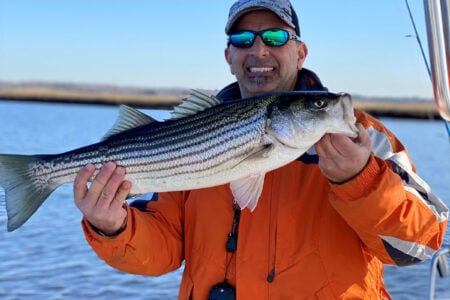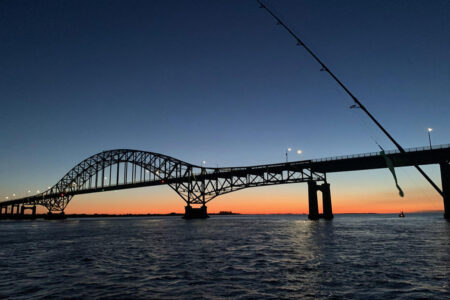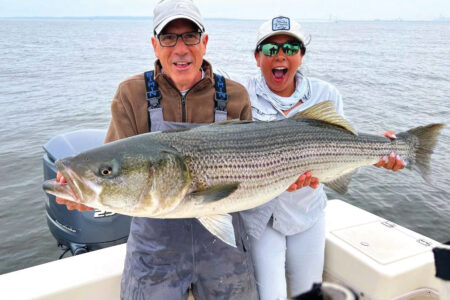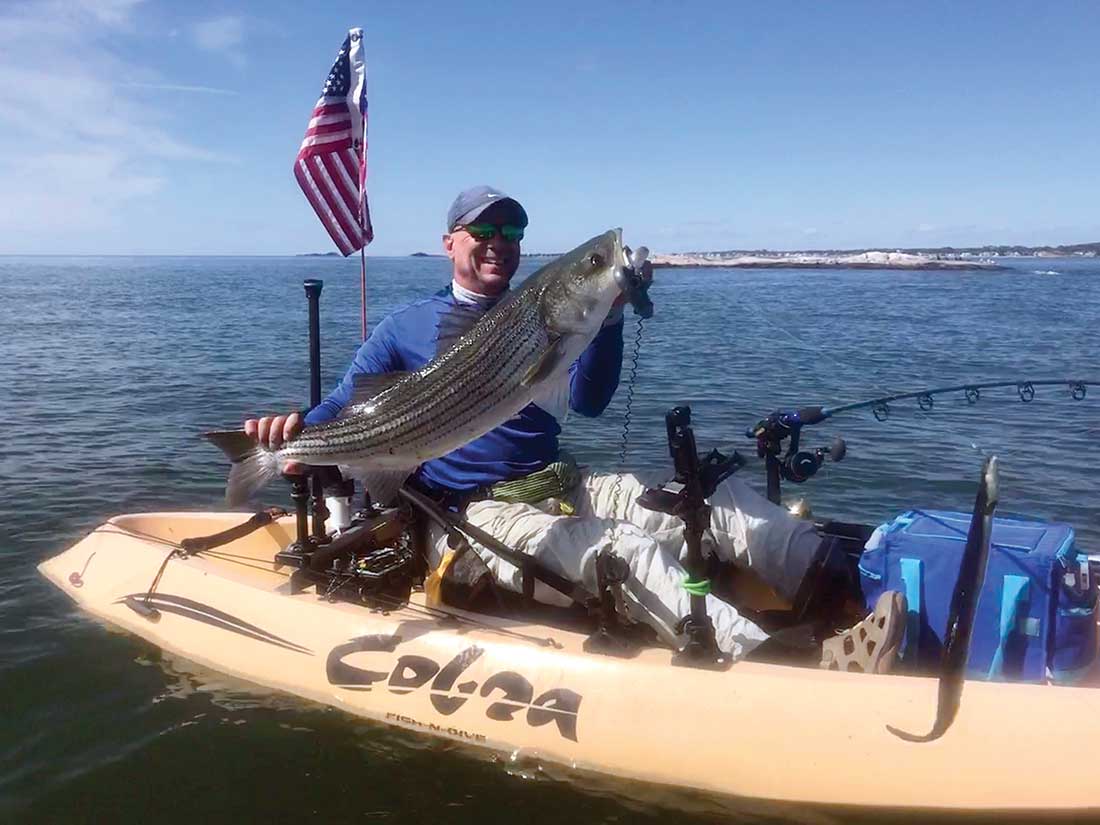
The kayak is the perfect platform to target big bass on shallow, near-shore reefs.
The morning broke cool and with a slight chop on the water. Cloud formations created an overcast hue that would hold for the rest of the day—perfect conditions for intercepting some striped bass! I launched my yak and began paddling to that magic zone so very few fishermen can reach with larger craft: skinny water inshore reefs. These spots can be found almost anywhere along the Southern New England coastline, and they lend themselves perfectly to the stealthy, silent nature of the kayak.
For the purposes of this article, skinny water reefs are defined as the areas just out of reach for the shore fisherman and too tight or too rocky for the average boater. It’s an area that sees reduced fishing pressure and can hold some trophy fish. In general they feature depths of just 6 to 10 feet of water with some rocky outcroppings, which keeps the boaters at bay and the bass happy.
Find the Lanes
For this type of fishing I primarily use live eels. I keep an alternate spinning rod rigged and ready with a favorite topwater lure in case a feeding school of fish shows up, and this happens more often than you think so be prepared. I target the feeding lanes that develop around and just off of defined structure. Usually there are three lanes to fish on both sides of the structure. All lanes hold fish at various stages of the tide, it’s your job to locate them as conditions unfold. Local knowledge of the reef can help tremendously as these patterns hold for defined periods and seasons.
When I make my initial approach I begin on the calmer side as rips often indicate water being stacked against an obstruction. The bait gets swept up and over these obstructions and striped bass will be waiting on the downward side. They are opportunistic fish built for strong powerful maneuvers in just these conditions. The question is, “Are the bass holding tight to the structure or staged out at various depths?” This is where good trolling techniques and keen observation is beneficial. Look for three distinct areas: the obstruction lane, the middle lane and the flats. Here’s how to identify and fish each feeding lane.
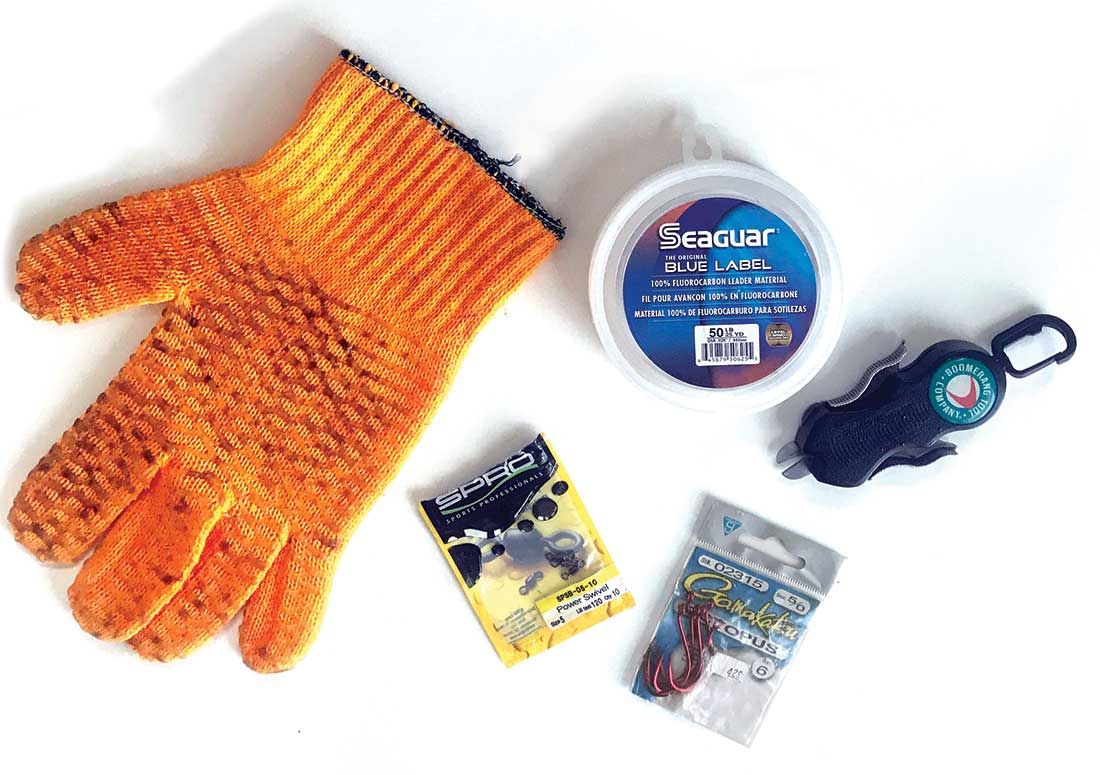
Obstruction Lane
This is the one closest to the targeted structure yet still deep enough to float your kayak. Typically 2 to 4 feet deep, this is in-tight work and I only target this area close to high tide and when the current is close to slack. Be careful! If the current is ripping, leave this area alone; come back to it around slack tide. If the fish are there and you must fish during stronger currents try trolling your bait farther back and keep the rod on the opposite side of the rip. That way when the fish hits you can quickly turn out and away from the rip using her strength to turn the bow of the kayak and pull you free. During calmer water I fish my eel fairly tight to the kayak.
Middle Lane
This is the first defined drop-off closest to the rip. This is usually 6 to 8 feet of water with at least a 2-foot depth change. This is my favorite starting point as I gather visual information and assess the tide and conditions when first arriving. Two or three passes parallel to the rip or structure will yield a ton of information and usually the first bite of the day. When trolling a live eel change it up after two or three passes without a hit. By this I mean slowing down or speeding up and lengthening or shortening the amount of line in the water in measured increments. Optimum trolling technique is to pause long enough for the eel to stop swimming forward and start heading for the bottom and safety. When you start moving forward again it will lift the head of the eel causing a yo-yo up and down swim through the water column. This is what you want.
The Flats
This is the flattened-out area just after the first drop-off and before the bottom changes to deeper water or flattens out for a big stretch. These flats can be anywhere from 8 to 12 feet deep and extend out a good distance from the rip. I typically like to fish within eyesight of the defined structure but still on the flats. Sometimes fish can be further out than expected, so if the bite is slow don’t be afraid to range out always realizing the original structure is what sets up the feeding opportunities below it. This area is often overlooked because it is far enough from the rip to look unproductive – wrong! Bait will get swept along especially during peak tide activity pretty quickly and try to regroup here, and bass will be waiting for the easy meal. You might feel awkward fishing here as common sense tells you to fish the structure. I’ve caught enough big bass in this zone to never overlook it, and during peak tides it’s my favorite spot. Above all else, bass are lazy and conserve energy whenever possible. If the bait’s here so are the bass.
I troll this area with my eel much farther back. This allows it to drop down in the deeper water and swim. This area also offers the luxury of swinging wide when making a turn, but stay alert; you will get a large portion of your fish as you make these big lazy turns. It puts the eel in a different part of the water column as well as an area not directly trolled over. As the eel drops due to reduced forward speed on the turn hang on; bass find this change in speed and direction irresistible and will hammer your offering.
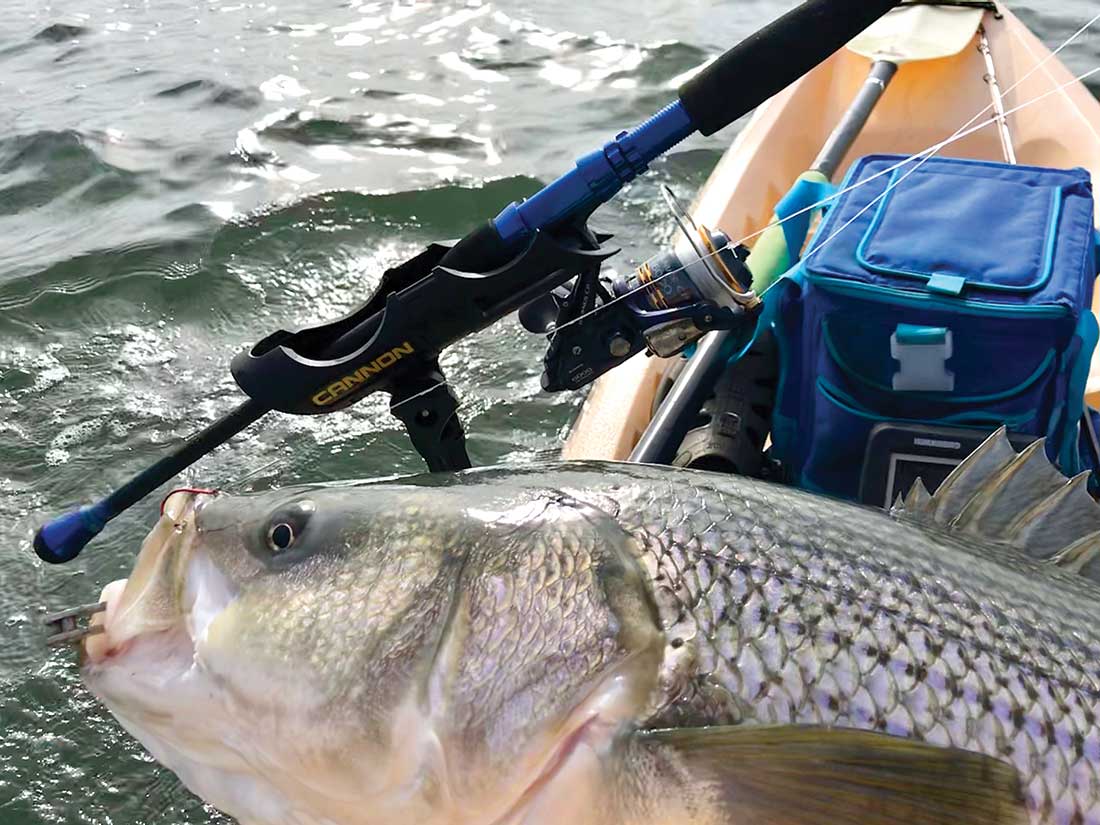
Rigging and Trolling an Eel
For almost all my big bass expeditions, my preferred bait is the live eel. When properly addressed they are easy to keep alive and handle. I keep them in a small cooler with a Ziploc bag of ice placed on top of them. This settles them down and makes for easy handling with a cotton glove. They perk up as soon as they hit the water.
All my reels for this type of fishing are spinning with a bait-runner option. I use 50-pound braid backing such as PowerPro with a top shot of 50 yards of 40-pound Momoi’s Hi-Catch monofilament. I then use a small Spro barrel swivel small enough to easily pass through the guides and rated at 120-pound test. This keeps the line from twisting and is critical to a successful trip. To the swivel I attach a 4-foot long shock leader of 50-pound Seaguar fluorocarbon. Next comes the hook and this is the key. I use a very small hook and very specific – Gamakatsu Octopus 4/0 and 5/0 in red. The small hook is pinned under the chin and through the top of the head as close to the lips as possible. The small hooks seem not to bother the eel and therefore they don’t put their tail up inside the bend and try to dislodge it.
I use a bait-runner reel with at least 20 pounds of drag like the Shimano Thunnus 6000 matched with a custom rod from Crafty One Customs out of Portsmouth, RI.
When the eel is picked up by a bass they move away at considerable speed; count three seconds and engage the reel. Allow the line to come tight and then set the hook. The first 30 seconds are explosive with a big fish literally towing the kayak. Allow the rod to absorb most of the stress of the fish pulling for the bottom, and eventually she will tire and turn. Take it slow and easy; when she sees the kayak she’ll make one last attempt at freedom. At this point something like a Boga Grip or a lip gripper is your best friend, especially for catch and release. Be careful with the fish boatside and reduce the amount of time spent out of the water for unhooking and photographs. Once unhooked, you can swim the fish next to the kayak, attached to the gripper, and release her when she’s ready.
